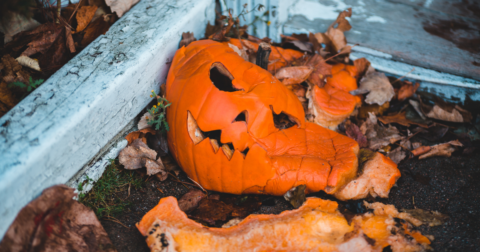Explainer
How Overconsumption Affects the Environment and Health, Explained
Climate•12 min read
Reported
Pumpkins in parks and your backyard could be doing more harm than good.


Words by Grace Hussain
Kathy Halamka has quite a crew to feed. At Unity Farm Sanctuary in Sherborn, Massachusetts, she cares for three very excited cattle — Audrey Heifer, Pal McTrouble and Elliott Steer — as well as Dudley, a shaggy white Scottish highland steer weighing in at almost a ton.
Pumpkins are an occasional indulgence for the cows, but other animals at the sanctuary benefit from the gourds too. “It’s a dewormer” for the birds, says Halamka, and for pigs, a central part of their diet.
That’s not the case for every animal, says Matthew Hayek, PhD, an environmental scientist at New York University, especially wildlife. Every year 1.3 billion pounds of pumpkins end up in landfills, resulting in massive amounts of food waste and methane emissions as the gourds break down. Yet tossing your pumpkins into the woods isn’t a good alternative, say wildlife and environmental experts. Here’s why.
Leaving pumpkins in your yard or in a local park for wildlife has long been touted as the sustainable solution to pumpkin waste. However, according to Hayek, who teaches environmental science, disposing of pumpkins in nature actually does more harm than good.
“Human food is preferred by only a few species,” he says. So when we leave pumpkins out, it’s usually the ones that are already overpopulated who benefit, like deer, rats or squirrels, making it even easier for them to outcompete other animals.
It’s not just land animals, says Hayek. “A little bit of nutrient can be a really good thing [for the water system] but too much of it overwhelms our local waterways causing outbreaks of algae and destruction of ecosystems.”
“When we think about fostering diversity we want to focus on the [wild animals] that have a harder time,” says Hayek. If you really want to support your local ecosystem, he suggests building a bee hotel or planting native wildflowers instead.
One solution to pumpkin waste that Hayek does recommend is being more selective about the types of gourds you choose. “We are growing a lot of pumpkins that are only serving an aesthetic purpose,” he says. Instead, he advises looking for those that “are also good for roasting or cooking,” such as Long Island Cheese pumpkins, which are decorative and delicious.
As an alternative to trashing them, Hayek suggests composting those you can’t cook with. That’s exactly what Halamka does for any pumpkins she can’t feed to their animal residents — namely those that have been carved or decorated. “If people put them into the trash, they won’t actually be able to do any good for anybody,” says Halamka.
Though she encourages people to buy fewer pumpkins to reduce waste, Halamka says community pumpkin donations have gone to good use at Unity Farm Sanctuary, especially during the holidays.
The farms and neighborhoods surrounding the sanctuary donate upwards of 1000 to 1500 pumpkins every year, Halamka estimates. With proper storage, that’s enough pumpkins to last them through January, significantly cutting the cost of feeding their residents, especially the pigs.
The work they do at Unity Farm Sanctuary is about more than just saving farmed animals. The organization takes a prosocial approach to their work — one that recognizes the interconnectedness of social, environmental and animal justice.
The pumpkin donation program exemplifies that philosophy. The pumpkins are kept out of the landfill and waterways, and the animals get a delicious treat.
“The community is strengthened by coming together to do something in a positive way,” says Halamka. “We’re not asking [people who donate pumpkins] to be plant-based or vegan,” she says. “We’re asking them to be kind,” something she believes opens the door for furthering their mission of getting “people to recognize the unique sentience of [their] residents.”
“One pumpkin probably doesn’t make a difference,” says Hayek “but the reason that we do all sorts of things is because we know it makes a collective difference.”
This piece has been updated to correct the spelling of Kathy Halamka’s name.